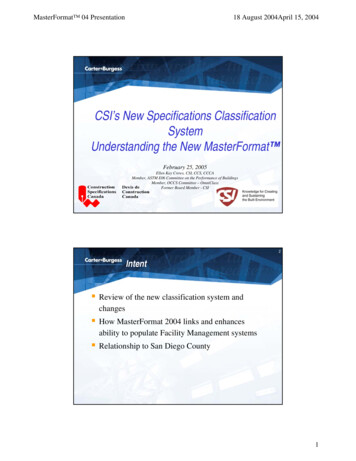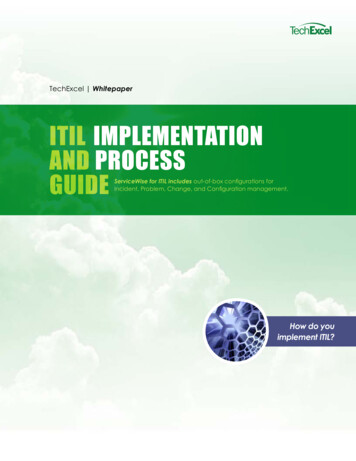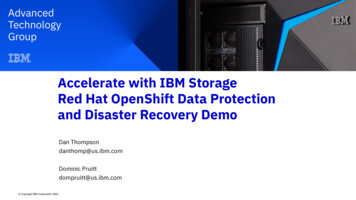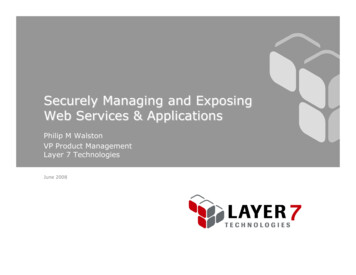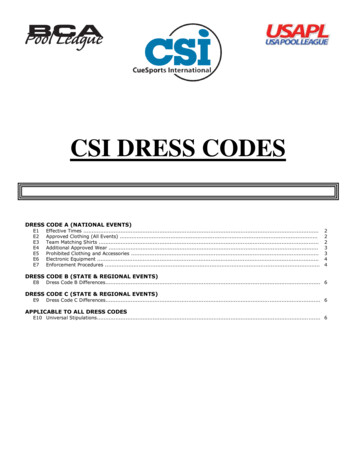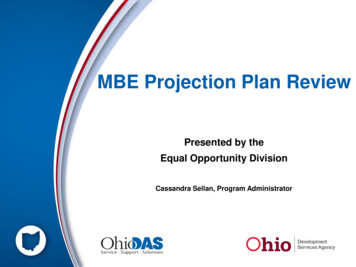
Transcription
CSIPODLAS3/17/2006 11:00 AM“The CSI Effect”: Exposing the MediaMythDr. Kimberlianne Podlas INTRODUCTION . 430I. CSI: CRIME SCENE INVESTIGATION AND “THE CSI EFFECT”. 432A. CREATING UNREASONABLE EXPECTATIONS AND INCREASINGTHE PROSECUTION’S BURDEN . 433B. INFALLIBILITY OF SCIENCE . 437C. INCREASING INTEREST IN FORENSIC SCIENCES . 442II. THE INFLUENCE OF TELEVISION. 443A. THEORY OF INFLUENCE . 447III. CONSTRUCTING A “CSI EFFECT” . 451IV. INVESTIGATING THE CSI EFFECT . 453A. OVERVIEW . 453B. INVESTIGATING CSI EPISODE CONTENT . 453C. INVESTIGATING INFLUENCE ON VIEWER VERDICTS . 4541. Instruments. 4542. Criminal Law Scenario . 4553. Verdict sheet . 455D. RESULTS . 4571. Television Exposure Measures . 457E. ANALYSIS OF VERDICTS . 458 Assistant Professor of Media Law, Dept. of Broadcasting & Cinema, University ofNorth Carolina, Greensboro. Former Associate Appellate Counsel, The Legal AidSociety (Criminal Appeals Bureau); JD magna cum laude, SUNY Buffalo (1991); BSmagna cum laude, SUNY Buffalo (1988).429
CSIPODLAS4303/17/2006 11:00 AMFORDHAM INTELL. PROP. MEDIA & ENT. L.J. [Vol. 16:429]1. The Embedded “Not Guilty” Verdict . 4582. CSI-Influenced NOT GUILTY Verdicts . 4593. Guilty Verdicts. 4594. CSI Impact Measures . 4595. Statistical Analysis of NOT GUILTY verdicts andfrequency of CSI viewing. 459V. DISCUSSION: THE “CSI EFFECT” MYTH EXPOSED . 461VI. EMPIRICAL CONCERNS . 464CONCLUSION. 465INTRODUCTIONAlmost since the advent of television, legal scholars andpractitioners alike have contemplated the impact of law-orientedentertainment programming, such as Perry Mason, LA Law, andThe People’s Court, on the public.1 Even the Supreme Court2 andthe American Bar Association3 have acknowledged that televisionimpacts the public’s perception of the legal system. Consequently,in the last decade, scholars have begun investigating the impact of1See generally MICHAEL ASIMOW & SHANNON MADER, LAW AND POPULAR CULTURE(2004); PRIME TIME LAW (Robert M. Jarvis & Paul R. Joseph eds., 1998); AnthonyChase, Lawyers and Popular Culture: A Review of Mass Media Portrayals of AmericanAttorneys, 1986 AM. B. FOUND. RES. J. 281 (1986); see Anthony Chase, Toward a LegalTheory of Popular Culture, 1986 WIS. L. REV. 527, 547-554 (1986) [hereinafter Chase,Toward]; David A. Harris, The Appearance of Justice: Court TV, ConventionalTelevision, and Public Understanding of the Criminal Justice System, 35 ARIZ. L. REV.785, 786 (1993); Kimberlianne Podlas, The Monster in the Television: The Media’sContribution to the Consumer Litigation Boogeyman, 34 GOLDEN GATE U. L. REV. 239,261 (2004) [hereinafter Podlas, Monster].2See Richmond Newspapers v. Virginia, 448 U.S. 555, 575 (1980) (“educative effect”on public of televised proceedings); Estes v. Texas, 381 U.S. 532, 548-49, 589 (1965)(Harlan, J., concurring) (explaining that television performs educational function byacquainting public with judicial process); see also RICHARD L. FOX & ROBERT W. VANSICKEL, TABLOID CRIMINAL JUSTICE IN AN AGE OF MEDIA FRENZY 5–8 (2001) (describingacademic theories of impact of media coverage of trials on public attitudes).3American Bar Association Report on Perceptions of the US Justice System, 62 ALB.L. REV. 1307, 1315 (1999) (stating that “media can and does impact some people’sknowledge”).
CSIPODLAS2006]3/17/2006 11:00 AMEXPOSING THE MYTH OF “THE CSI EFFECT”431pop cultural representations of law, such as dramatic and “reality”shows, on the public.4CBS’s top-rated drama C.S.I.: Crime Scene Investigation5 isthe most recent television program to interest the public as well asthe Bar. National popular press stories, beginning with a 2004USA Today report6 and culminating with the U.S. News & WorldReport’s spring cover story, “The CSI Effect, How TV is DrivingJury Verdicts All Across America,”7 charge that the popular dramais causing a “CSI Effect.” If these stories are to be believed, CSI isaltering the way in which jurors assess criminal trial evidence, thusimpacting the administration of justice. Although there is somesurface appeal and anecdotal evidence to support such claims,8there is, as of yet, no empirical evidence to substantiate them.9Nevertheless, if CSI contributes to the pop cultural landscape thatshapes perceptions of the legal process or if it impacts jurordecision-making, “The CSI Effect” merits serious investigation.Consequently, this study attempts to amass the first empiricalevidence of whether a “CSI Effect” exists, what it is, and whether4See, e.g., ASIMOW & MADER, supra note 1; Kimberlianne Podlas, As Seen on TV: TheNormative Influence of Syndi-Court on Contemporary Litigiousness, 11 VILL. SPORTS &ENT. L.J. 1, 1–2 (2004) [hereinafter Podlas, As Seen on TV]; Robert A. Clifford, TheImpact Of Popular Culture on the Perception of Lawyers, 28 LITIG. 1 (Fall 2002);Lawrence M. Friedman & Issachar Rosen-Zvi, Illegal Fictions: Mystery Novels and ThePopular Culture Image of Crime, 48 UCLA L. REV. 1411 (2001); RICHARD K. SHERWIN,WHEN LAW GOES POP (2000) [hereinafter Sherwin, POP]; PRIME TIME LAW, supra note 1;Richard K. Sherwin, Introduction: Picturing Justice: Images of Law and Lawyers in theVisual Media, 30 U.S.F.L. REV. 891, 898 (1996) [hereinafter Sherwin, Introduction];David M. Spitz, Notes And Comments: Heroes Or Villains? Moral Struggles vs. EthicalDilemmas: An Examination Of Dramatic Portrayals Of Lawyers And The LegalProfession In Popular Culture, 24 NOVA L. REV. 725, 729-30 (2000) (intended for publicas whole).5See THE HOLLYWOOD REP., Apr. 20, 2005, at 13. CSI: Crime Scene Investigationaveraged 26.4 million viewers for the 2004-05 television season. Id.6Richard Willing, “CSI Effect” Has Juries Wanting More Evidence, USA TODAY,Aug. 5, 2004, at 01A.7Kit R. Roane, The CSI Effect, How TV is Driving Jury Verdicts All Across America,U.S. NEWS & WORLD REP., Apr. 25, 2005, at 48.8Cf. Simon Cole and Rachel Dioso, Editorial Page; Taste Commentary, Law And TheLab: Do TV Shows Really Affect How Juries Vote? Let’s Look At The Evidence, THEWALL STREET JOURNAL, May 13, 2005 (“finding only anecdotal evidence”).9See Cole and Dioso, supra note 8, at 48 (stating that there is “not a shred ofevidence” of CSI Effect).
CSIPODLAS4323/17/2006 11:00 AMFORDHAM INTELL. PROP. MEDIA & ENT. L.J. [Vol. 16:429]it impacts the administration of criminal justice via jurordeliberations. To that end, after detailing three conceptions of“The CSI Effect,” this paper advances a theory of media influenceon lay understandings of law. It then extends that base to articulatethe operation of a so-called “CSI Effect.” Next, the paper turns toempirical investigation, presenting a study of 254 jury eligibleadults who responded to surveys of television and CSI viewinghabits as well as to a criminal law scenario measuring the potentialimpact of CSI viewing. The results show that, despite numerousmedia stories and law enforcement warnings of a “CSI Effect”crippling our criminal justice system, no such effect exists—atleast not any effect that harms, rather than helps, the prosecution.I. CSI: CRIME SCENE INVESTIGATION AND “THE CSI EFFECT”As noted, “The CSI Effect” refers to a supposed impact of thepopular CBS crime drama CSI: Crime Scene Investigation.10 CSI,which debuted in October 2000,11 is a top-rated drama on networktelevision. Closing the 2004-05 season as the second highestwatched program, it has an average audience of 26.4 millionviewers.12 As further testament to its popularity, the program hasspawned a number of spin-offs,13 and can now be seen on cableand in syndication.14 Creator Anthony E. Zuiker explained that hisshow rests on “the notion that blood, hair, saliva, skin, et cetera areforensically designed to tell an investigator what has happenedwithout having any witness to a crime.”15 He thus uses thisintrinsic narrative to design a program where forensic evidence“speak[s] for those who cannot speak for themselves. . . .”1610See Willing, supra note 6.MIKE FLAHERTY & CORRRINE MARRINAN, CSI: CRIME SCENE INVESTIGATIONCOMPANION 9 (2004).12ENT. WKLY., June 2005; THE HOLLYWOOD REP., supra note 5, at 13 (reportingNielsen Media Research data).13These spin-offs include CSI: Miami and CSI: NY. VARIETY, Apr. 18-24, 2005, at 14(reporting Nielsen Media Research).14The syndicated version of CSI can be seen on approximately 244 stations, andattracts an audience of 5 million viewers. Id.15Id. at 9.16Id. Elizabeth Devine, former crime lab technician, and supervising producer of CSI:Miami, explains that these are the first shows to make analysis interesting: “We . . .11
CSIPODLAS2006]3/17/2006 11:00 AMEXPOSING THE MYTH OF “THE CSI EFFECT”433“The CSI Effect” has been defined in three different ways. Thebest-known definition states that CSI creates unreasonableexpectations on the part of jurors, making it more difficult forprosecutors to obtain convictions. The second definition, whichruns contrary to the first, refers to the way that CSI raises thestature of scientific evidence to virtual infallibility, thus makingscientific evidence impenetrable. The final definition focuses onCSI’s increasing lay interest in forensics and science. Thus,viewers who serve as jurors will be more interested in and able tofollow scientific evidence. They may even become interested inacademic training and careers in the forensics field. Eachdefinition is addressed in greater detail below.A. Creating Unreasonable Expectations and Increasing theProsecution’s BurdenThe CSI-inspired effect receiving the lion’s share of mediaattention17 refers to inflated jury expectations regarding evidentiaryproof and a consequent increase in the prosecution’s burden. Inthe typical CSI episode, each crime is solved with forensic tests,and these tests always discern the identity of the culprit. Thisnarrative “romanticize[s] forensic science,” creating unreasonableexpectations in the minds of jurors.18 Jurors become conditionedthat every crime can be solved through forensic evidence, and thatforensic evidence of guilt exists in every crime. As applied to theassessment of criminal trial evidence, jurors will expect forensicevidence in every case,19 and require it before they will convict.20slow[ed] things down to say, ‘This is cool stuff . . . .’” Stefan Lovgren, “CSI Effect” IsMixed Blessing For Real Crime Labs, NATIONAL GEOGRAPHIC NEWS, Sept. 23, 2004, at2. Indeed, Zuiker has described the show to be “educational,” because “[p]eople knowscience now . . . .” Prosecutors Feel the ‘CSI Effect’, CBSNEWS, Feb. 10, ningnews/main673060.shtml?CMP ILC-SearchStories (quoting Zuiker) (last visited Dec. 20, 2005).17One version of the “CSI Effect,” i.e., inflated jury expectations cripplingprosecutions, obtains the majority of the coverage. Cole and Dioso, supra note 8, at 48.18Craig M. Cooley, Forensic Individualization Sciences and the Capital Jury: AreWitherspoon Jurors More Deferential to Suspect Science than Non-Witherspoon Jurors?,28 S. ILL. U. L.J. 273, 273 (2004) [hereinafter Cooley, Forensic].19Craig M. Cooley, Reforming the Forensic Science Community to Avert the UltimateInjustice, 15 STAN. L. & POL’Y REV. 381, 386-87 (2004) [hereinafter Cooley, Reforming](jurors increasingly looking for forensic evidence in every case due to CSI); Editorial,
CSIPODLAS4343/17/2006 11:00 AMFORDHAM INTELL. PROP. MEDIA & ENT. L.J. [Vol. 16:429]Where forensic evidence does not exist, jurors may conclude thatthe evidence necessary to justify a guilty verdict does not exist, orinterpret its absence as justifying acquittal.21In addition, prosecutors complain that “The CSI Effect” createsunreasonable expectations about forensic evidence.22 First, jurorsweaned on CSI will expect police investigators to follow the scriptof CSI.23 When the collection of evidence deviates from thisscript, jurors will be more critical than would their predecessors.Second, jurors will expect scientific and quasi-scientific evidenceto be conclusive.24 This, however, is not always possible. As oneinvestigator lamented, “On TV, it’s all slam-dunk evidence . . . .Now juries expect the same thing—and that’s a big problem.”25Third, CSI furthers flawed notion that “it is always possible toextract useful forensic evidence.”26 Even when available, forensicevidence is often contaminated and thus cannot be used orCSI Effect; Jurors Overestimate Usefulness Of DNA Evidence, TELEGRAM & GAZETTE(WORCESTER, MA), Jan. 8, 2005, at A.12 (jurors are “conditioned to expect forensicevidence” (quoting Suffolk County District Attorney Daniel Conley)).20Enric Volante & Kim Smith, ‘CSI Effect’ Impacts Justice In Tucson, ARIZ. DAILYSTAR, May 8, 2005 (ADA asserting that some cases turn on lack of “TV-inspired”evidence); Cole and Dioso, supra note 8, at 48 (noting claims of juries refusing to convictwithout “fancy forensic evidence”); but see Volante and Smith, supra note 20 (SuperiorCourt Judge relates having not seen a case “won or lost” over lack of CSI-type evidence).21Roane, supra note 7, at 48. Peoria’s State Attorney asserts that when the prosecutionoffers less evidence than jurors are accustomed to seeing on TV, “it is viewed asreasonable doubt.” Id.22One prosecutor complained that jurors expect same-day DNA and toxicology tests.Prosecutors Feel the ‘CSI Effect’, supra note 16; cf. Willing, supra note 6 (CSI promotesnotion that forensic science is fast). Of course, no trial ever takes place one day afterarrest, but usually 10–14 months thereafter.23Lovgren, supra note 16.24Id.; Roane, supra note 7, at 50; Cooley, Reforming, supra note 19, at 386–87 (jurorslooking for forensic evidence).25Roane, supra note 7, at 49.26Panel Three: The Role of Scientific Evidence, 80 IND. L.J. 69, 87 (2005) [hereinafterPanel) (CSI furthers notion that “it is always possible to extract useful forensicevidence,” but estimating that forensic evidence is available in only 20% of capitoleligible cases); Volante and Smith, supra note 20 (tests do not always “produce results”);Renee A. Germaine, Comment: You Have The Right To Remain Silent. You Have NoRight To Your DNA, 22 J. MARSHALL J. COMPUTER & INFO. L. 759, 792 (2004) (DNA notalways available).
CSIPODLAS2006]3/17/2006 11:00 AMEXPOSING THE MYTH OF “THE CSI EFFECT”435introduced at trial.27 In other instances, although powerful forensictools like DNA28 evidence are available,29 they are neither the onlynor best method to prove guilt.Notwithstanding CSI’s evidentiary impact, some individualsextrapolate that “The CSI Effect” heightens the People’s burden.30In a criminal case, the prosecution carries the burden of provingthe defendant guilty31 “beyond a reasonable doubt.”32 Courts havedescribed “beyond a reasonable doubt” to mean that: (a) theevidence excludes to a moral certainty every hypothesis but guilt;33(b) the inference of guilt is the only one that can be drawn from thefacts; or (c) the evidence excludes every hypothesis of innocence.34Where jurors refuse to convict without definitive forensicevidence, regardless of the strength of testimonial evidence, orunless the prosecution can exclude innocence via such scientific27See Willing, supra note 6; Editorial, CSI Effect; Jurors Overestimate Usefulness OfDNA Evidence, supra note 19, at A12 (contamination and deterioration of DNAevidence).28DNA is found in nucleated cells and its primary function is to encode and transmitheritable traits from parent to child. Veronica Valdivieso, DNA Warrants: A Panacea forOld, Cold Rape Cases?, 90 GEO. L.J. 1009, 1013 (2002). Ninety-Nine and nine tenthspercent of DNA is identical from person to person, and the variable region can be used toidentify individuals. Id. at 1013-14. In DNA testing, technicians compare thepolymorphisms of four or five different loci of a suspect’s DNA with those found at acrime scene. Id. at 1014. If the samples are identical, there is a match, and a scientist cancalculate the probability that the samples came from the suspect (based on the frequencyof the polymorphisms in the general population). Id.; see also Andrew C. Bernasconi,Comment: Beyond Fingerprinting: Indicting DNA Threatens Criminal Defendants’Constitutional and Statutory Rights, 50 AM. U. L. REV. 979, 986–88 (2001).29See Willing, supra note 6 (DNA not always available). While DNA testing is amongthe more accurate forensic sciences, its results remain subject to human assessment, and,therefore, error. See Edward K. Cheng, The Powers and Pitfalls of Technology:Reenvisioning the Law Through the DNA Lens, 60 N.Y.U. ANN. SURV. AM. L. 649, 650(2005); Roane, supra note 7.30See Cole and Dioso, supra note 8, at 48 (recounting claims of jurors refusing toconvict without forensic evidence); Roane, supra note 7, at 50 (quoting State Attorney,“The burden [CSI] places on us is overwhelming”).31The defendant enjoys a presumption of innocence, until proven guilty. Coffin v.U.S., 156 U.S. 432, 453 (1895).32In Re Winship, 397 U.S. 358, 364 (1970).33People v. Bennett, 49 N.Y. 137, 144 (1872).34See, e.g., People v. Smith, 162 N.Y. 520, 528–29 (App. Ct. 1900).
CSIPODLAS4363/17/2006 11:00 AMFORDHAM INTELL. PROP. MEDIA & ENT. L.J. [Vol. 16:429]evidence, it increases the constitutional35 burden from “beyond areasonable doubt” to “beyond any and all doubt.”36 In support ofthis proposition, prosecutors are relating anecdotes of jurors takinglonger to deliberate37 or asking more questions.38 Indeed, onehomicide investigator confessed, “‘[o]ur biggest fear is that whatthese shows will mainly do is that these people will start gettingacquitted.’”39While CSI may increase the practical (if not the legal) burden,empirical evidence suggests prosecutors typically obtainconvictions on less than a reasonable doubt. Although legalcommentators have estimated the mathematical level of guilt tomean more than ninety percent certainty, empirical studies showthat jurors require as little as seventy percent certainty to meet thisburden.40 Nonetheless, if jurors are now more likely to abide bythe constitutional standard or less inclined to convict,41 “The CSIEffect” effectively increases the prosecution’s burden.4235Although the “beyond a reasonable doubt” burden was first used in the United Statesduring the 1770 Boston Massacre trials, Eric Lillquist, Absolute Certainty and the DeathPenalty, 42 AM. CRIM. L. REV. 45, 48 (2005), it was not until 1970 that the SupremeCourt declared it constitutionally required in criminal trials. In Re Winship, 397 U.S. at364.36Michael Mello, Outlaw Executive: Crazy Joe, The Hypnotized Witness and theMirage of Clemency in Florida, 23 J. CONTEMP. L. 1, 42 (1997) (beyond any doubt isgreater than “beyond a reasonable doubt . . .”).37Volante & Smith, supra note 20.38Id. Commentators have long debated whether jurors are capable of understandingcomplex evidence. See Lynne ForsterLee & Irwin A. Horowitz, The Effects of Jury-Aidinnovations on Juror Performance in Complex Civil Trials, 86 JUDICATURE 184, 184(Jan.- Feb. 2003) (discussing jurors in civil litigation).39Volante & Smith, supra note 20 (quoting Pima County Sergeant and homicideinvestigation supervisor).40Erik Lillquist, Recasting Reasonable Doubt: Decision Theory and the Virtues ofVariability, 36 U.C. DAVIS L. REV. 85, 112 (2002).41See Cole and Dioso, supra note 8, at 48.42In other words, while the prosecution’s burden may increase, it may not increasebeyond the Constitutional standard. Of course, from a prosecutorial perspective, thismight be seen as an infection preventing both the prosecution and jury from doing itsrespective jobs.
CSIPODLAS2006]3/17/2006 11:00 AMEXPOSING THE MYTH OF “THE CSI EFFECT”437B. Infallibility of ScienceThe second definition of “The CSI Effect” is the converse ofthe first. This definition focuses on the way that CSI elevatesscientific evidence to an unsupported level of certainty thusbolstering the prosecution’s case.Therefore, just as lawenforcement fears that CSI will cause jurors to misinterpret theabsence of forensic evidence, others fear that CSI will lead jurorsto blindly believe forensic evidence.Although the public is “perpetually inundated with distortedperceptions of forensic science capabilities,”43 attorneys, legalresearchers, and even “real” scientists have long criticized “expert”testimony and certain forensic conclusions as either not being veryscientific or as portraying human judgments as infalliblefindings.44 Courts, too, “have become increasingly uncomfortablewith the ever-expanding area of scientific expertise.”45 Indeed,several courts have cautioned that scientific evidence, presented asproof, “can assume [the] posture of mystic infallibility in the eyesof [the] jury . . . .”46 CSI may further this perception.On its own, scientific evidence can be rather seductive. Inconjunction with CSI, it becomes insurmountable. For example,CSI portrays scientific evidence as infallible.47 It shows forensics43Cooley, Reforming, supra note 19, at 388.Id. (much forensic testing based on human conclusions and judgments); Willing,supra note 6 (asserting that real scientists say the fault of CSI is that its science is beyondreproach); id. (stating that defense attorneys complain that crime scene testing is notalways accurate).45Cynthia Stevens Kent, Daubert Readiness of the Texas Judiciary, 6 TEX. WESLEYANL. REV. 1, 4 (1999); see generally PETER H. HUBER, GALILEO’S REVENGE: JUNK SCIENCEIN THE COURTROOM (1991). Huber spoke of “junk science,” i.e., “the mirror image of realscience . . . [with] none of the same substance.” Id at 2.46U.S. v. Addison, 498 F.2d 741, 744 (D.C. Cir. 1974); see also John W. Strong,Language and Logic in Expert Testimony: Limiting Expert Testimony By Restrictions ofFunction, Reliability, and Form, 71 OR. L. REV 349, 367 n.81 (1992) (“There is virtualunanimity among courts . . . that evidence perceived by jurors to be ‘scientific’ in naturewill have particularly pervasive effect.”); Edward J. Imwinkelried, The Next Step AfterDaubert: Developing a Similarly Epistemological Approach to Ensuring the Reliability ofNonscientific Expert Testimony, 15 CARDOZO L. REV. 2271, 2286 (1994) (courts fear thatscience projects “aura of infallibility”) (citation omitted) and (evidence perceived to bescientific will have “‘particularly persuasive effect’” on jury) (citation omitted).47Panel, supra note 26, at 82; see also Willing, supra note 6 (discussing the mistakennotion that criminal science always catches the culprit and is infallible); Cooley,44
CSIPODLAS4383/17/2006 11:00 AMFORDHAM INTELL. PROP. MEDIA & ENT. L.J. [Vol. 16:429]effortlessly identifying the culprit, but never shows it “just aseasily” inculpating the wrong person.48 This absolute certaintymight lead jurors to believe that crime scene evidence is alwaysaccurate,49 or, at least, more conclusive than it is.50 Consequently,jurors will be unwilling to accept that forensic “proof” could becompromised by human error, or is merely an educated guess.51On CSI, science leads to a singular, objective correct answer.Yet, in real life, forensic conclusions are only as good as thetechnicians who retrieve the evidence, test it, and draw conclusionsfrom it.52 For example, unbeknownst to the average citizen, andnot disclosed on CSI, DNA53 can be interpreted differently bydifferent technicians.54Reforming, supra note 19, at 390–91 (Forensics is fallible and the result of humanjudgment, hence, error); Andrew C. Bernasconi, Beyond Fingerprinting: Indicting DNAThreatens Criminal Defendants’ Constitutional and Statutory Rights, 50 AM. U. L. REV.979, 988–89 (2001) (Jurors see DNA as absolutely conclusive).48Cooley, Reforming, supra note 19, at 388.49Willing, supra note 6 (discussing the notion that forensic evidence is infallible); seealso Cooley, Reforming, supra note 19, at 393–94 (Forensic evidence claims it isfoolproof when it is not.).50Cole and Dioso, supra note 8, at 48 (quoting Lisa Steele, co-chair of the ForensicEvidence Committee for the National Association of Criminal Defense Lawyers, “CSImak[es] folks less skeptical about the potential for forensic error or fraud.”); see alsoWilliam C. Thompson, Subjective Interpretation, Laboratory Error and the Value ofForensic DNA Evidence: Three Case Studies, 96 GENETICA 153, 153 (1995) (claimingDNA determinations can have surprising problems).51Willing, supra note 6; see also Cooley, Reforming, supra note 19, at 388–89.52Cooley, Reforming, supra note 19, at 391 (Forensics are “subjective determinationsby law enforcement.”); see also Cooley, Forensic, supra note 18, at 398; Roane, supranote 7.53Valdivieso, supra note 28, at 1017-18; see also Cheng, supra note 29, at 649 (DNAtransformed practice of criminal justice.).54Roane, supra note 7, at 53 (showing DNA is subject to interpretation); see alsoWilliam C. Thompson, Accepting Lower Standards: The National Research Council’sSecond Report On Forensic DNA Evidence, 37 JURIMETRICS J. 405, 412 (1997)(DQa/Polymarker DNA tests are subject to human interpretation.); Cooley, Reforming,supra note 19, at 397 (discussing an increase of wrongful convictions since the advent ofDNA testing). An independent proficiency testing report showed that some labs failed toproperly match samples on DNA tests or transposed samples from one to another.Furthermore, these labs somehow announced the correct results after wronglyinterpreting the static data. Roane, supra note 7, at 53.
CSIPODLAS2006]3/17/2006 11:00 AMEXPOSING THE MYTH OF “THE CSI EFFECT”439This is troublesome since, in some instances, evidenceportrayed as “scientific” hardly resembles science at all.55 Itclearly is not the mechanical, concrete indicia of certainty thatjurors rely on it to be.56 Many of the techniques used in policeforensic testing have never been empirically proven by the greaterscientific community.57 In fact, a number of scholars havequestioned whether courtroom science, such as dog sniff evidence,hair analysis,58 bite-mark analysis,59 earprints,60 fingerprints,61 and55Cooley, Forensic, supra note 18, at 285 (stating that legal scholars and forensicskeptics question whether forensics is supported by legitimate and scientific laws); seealso Michael J. Saks, Merlin and Solomon: Lessons from the Law’s FormativeEncounters with Forensic Identification Science, 49 HASTINGS L.J. 1069, 1082 (1998)(finding that individualization prominent in forensics is contrary to conventional science);Lisa Arthur, Forensics Experts Are No Fans of CSI, WICHITA EAGLE, Dec. 25, 2002, at 2.Huber argues that forensics found its way into the courtroom because it could not survivethe scrutiny of the scientific method, and thus, was shunned by the scientific community.HUBER, supra note 45, at 3.56See Cooley, Reforming, supra note 19, at 395 (stating that jurors believe physicalevidence cannot be wrong or perjured).57Id. at 390–91 (“[V]ery little science actually encompasses the forensic sciences.”);see also Saks, supra note 55, at 1083 (“[P]robabilities employed by traditional [forensics]are subjective and intuitive.”); id. at 1091 (Forensics is driven by police process.).58Roane, supra note 7, at 51 (Hair analysis is “discredited almost uniformly.”); seealso Model Act: Model Prevention and Remedy of Erroneous Convictions Act, 33 ARIZ.ST. L.J. 665, 666–67 (2001) (discussing that previously accepted but now disputed); PaulC. Giannelli, Scientific Evidence in Civil and Criminal Cases, 33 ARIZ. St. L.J. 103, 11819 (2001) (stating that federal courts have re-examined and disallowed hair analysis).59Roane, supra note 7, at 54 (Bite-mark analysis lacks certainty.); see also Sandy L.Zabell, Fingerprint Evidence, 13 J.L. & POL’Y 143, 143–44 (2005) (showing that subjectto skepticism); Cooley, Reforming, supra note 19, at 396–97 (discussing misidentifiedbite marks); Saks, supra note 55, at 1081 (questioning bite mark analysis).60Roane, supra note 7, at 54 (stating that no scientific studies support concept); seealso State v. Kunze, 988 P.2d 977, 989–90 (Wash. Ct. App. 1999) (discussing thatearprints are not generally accepted as science and, therefore, are inadmissible).61Model Act: Model Prevention and Remedy of Erroneous Convictions Act, 33 ARIZ.ST. L.J. 665, 666–67 (2001) (showing that expert opinions based on traditionalmethodologies are no longer considered nearly as reliable as they once were); see alsoRoane, supra note 7, at 53–54 (stating that under scrutiny, the fingerprint match is notconsidered unimpeachable); Cooley, Reforming, supra note 19, at 396–97 (discussingmistaken fingerprint “analysis”); cf. Nathan Benedict, Fingerprints and the DaubertStandard For Admission of Scientific Evidence: Why Fingerprints Fail and a ProposedRemedy, 46 ARIZ. L. REV. 519, 520–21 (2004) (Eighty five percent of jurors believefingerprints to be most reliable form of identification.). For discussion of mistakenfingerprint analysis, see Simon A. Cole, Grandfathering Evidence: Fingerprint
CSIPODLAS 3/17/2006 11:00 AM 2006] EXPOSING THE MYTH OF "THE CSI EFFECT" 431 pop cultural representations of law, such as dramatic and "reality" shows, on the public.4 CBS's top-rated drama C.S.I.: Crime Scene Investigation5 is the most recent television program to interest the public as well as



